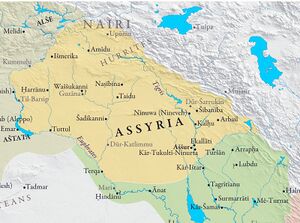Nairi
| Author: Laxman Burdak, IFS (R) |

Nairi was the Assyrian name for a Proto-Armenian (Hurrian-speaking) tribe in the Armenian Highlands,[1]
Variants
Jat Gotras Namesake
Location
It roughly corresponding to the modern Van and Hakkâri provinces of modern Turkey. The word is also used to describe the tribes who lived there, whose ethnic identity is uncertain. Nairi has sometimes been equated with Nihriya, known from Mesopotamian, Hittite, and Urartean sources.[4]
History
During the Bronze Age collapse (13th to 12th centuries BC), the Nairi tribes were considered a force strong enough to contend with both Assyria and Hatti. The Battle of Nihriya, the culminating point of the hostilities between Hittites and Assyrians for control over the remnants of the former empire of Mitanni, took place there, circa 1230. Nairi was incorporated into Urartu during the 10th century BC.
According to Trevor Bryce the Nairi lands were inhabited by what he calls "fierce tribal groups" divided into a number of principalities, and are first mentioned by Tukulti-Ninurta I (1243–1207 BC) when he defeated and exacted tribute from forty Nairi kings.[5] The names of twenty-three Nairi lands were recorded by Tiglath-Pileser I (1114–1076 BC). Their southernmost point was Tumme, known to have been south-west of Lake Urmia, and their northern one Daiaeni.[6]
These lands are known from the list of defeated kings[7] :
- "the king of Tumme,
- the king of Tunube,
- the king of Tuali,
- the king of Kindari,
- the king of Uzula,
- the king of Unzamuni,
- the king of Andiabe,
- the king of Pilakinni,
- the king of Aturgini,
- the king of Kulibarzini,
- the king of Shinibirni,
- the king of Himua,
- the king of Paiteri,
- the king of Uiram,
- the king of Shururia,
- the king of Albaia,
- the king of Ugina,
- the king of Nazabia,
- the king of Abarsiuni, and
- the king of Daiaeni."
It is believed that Nairi extended from the Tur-Abdin mountains in the south to the mountainous area southwest of Lake Van in the north.[8]
Shalmaneser III campaigned in the region, erecting a statue at the source of the Tigris. Bryce states that some of his "royal inscriptions indicate that the term now also denoted a specific region to the southwest of Lake Urmia, centred on the land of Hubushkia."[9]
Albrecht Goetze suggested that what he refers to as the Hurriland dissolved into a number of small states that the Assyrians called Nairi.[10]
An early, documented reference to Nairi is a tablet dated to the time of Adad-nirari I (13th century BC), which mentions the purchase of 128 horses from the Nairi region.
The Nairi fought against the southern incursions of the Assyrians and would later unite into Urartu.[11]
Jat History
Nehra: According to Bhim Singh Dahiya they are to be identified with Nara or Nehra clan of the Jats, the Nairi of West Asia. Assyrian inscriptions of Shalmaneser I (ca. 1270 BC) first mention a loose confederation called the Urartu or Nairi in North-East Anatolia, in the region around Lake Van. [12]
Bhim Singh Dahiya[13] has provided us Clan Identification Chart in which West Asian/Iranian name Nairi/Nahrian are identified with Nara/Nahra Jat clans of India.
External links
See also
References
- ↑ Redgate, Anne Elizabeth (2000). The Armenians. Wiley-Blackwell. p. 27. ISBN 978-0631220374.
- ↑ Jats the Ancient Rulers (A clan study)/Appendices/Appendix II, p.325, s.n. 104
- ↑ Jats the Ancient Rulers (A clan study)/Appendices/Appendix II, p.325, s.n. 104
- ↑ Trevor Bryce, The Kingdom of the Hittites 2005:316; Bryce locates Nairi north or northeast of modern Diyarbakir.
- ↑ Bryce, Trevor (2012). The World of The Neo-Hittite Kingdoms: A Political and Military History. Oxford University Press. p. 199. ISBN 978-0199218721.
- ↑ The Armenians — Page 27 by Elizabeth Redgate, A. E. (Anne Elizabeth) Redgate Grayson, IL, 1976 (pp. 12-13)
- ↑ "Assyrian Catalogue of Anatolian lands and leaders".
- ↑ The Origins of the Urartians in the Light of the Van/Karagündüz Excavations - Veli Sevin - Page 159 of 159-164
- ↑ Bryce, Trevor (2009). The Routledge Handbook of the Peoples and Places of Ancient Western Asia: The Near East from the Early Bronze Age to the fall of the Persian Empire. Routledge. p. 495. ISBN 978-0415394857.
- ↑ Götze, Albrecht (1974). Kulturgeschichte Kleinasiens. C H Beck. p. 190. ISBN 978-3-406-01351-5.
- ↑ "Schriftfunde" (in German). "Inscribed objects" (English translation)
- ↑ Bhim Singh Dahiya: Aryan Tribes and the Rig Veda, ( 1991) ,
- ↑ Jats the Ancient Rulers (A clan study)/Appendices/Appendix II, p.325, s.n. 104

